This vegetarian stir-fry sauce takes only 5 minutes to make, and it's filled with savory, toasty, and umami flavors! It's perfect for noodle or tofu stir fries and is easy to customize.

If you're looking for a quick vegetarian stir-fry sauce recipe to add to tofu, vegetables, and noodles or rice, then you've found the right recipe!
Like regional and cultural differences in BBQ sauce and peanut sauce, this is one of those staples that can be made in a thousand different ways. Stir-fry sauce is a catch-all term for sauces used in Asian stir-frying, but different cultures have different key ingredients used in their sauces.
This recipe is in no way a traditional stir-fry sauce, but it is a sort of combination of Chinese stir-fry sauces which uses soy sauce (light and dark) and toasted sesame oil and teriyaki sauce which uses fresh ginger and garlic.
Many stir-fry sauces call for oyster sauce, but my version doesn't use oyster sauce or other animal products, making it vegan and vegetarian as-is.
Jump to:
Why this recipe works
- Simple but high-imapct flavors: This vegetarian stir-fry sauce is salty, toasty, and made with fresh ginger and garlic for a punch of flavor. It takes just 5 minutes to mix together, but it can be made several days in advance, which allows the sauce to become even more flavorful.
- Versatile: Just toss this sauce in a hot pan with protein, vegetables, and noodles for a flavorful meal. I use this recipe in tofu noodle stir fries with a variety of vegetables.
- Pantry-friendly: Most of the ingredients used in this recipe are probably already in your pantry. While fresh ginger and garlic are preferred, dry ginger and garlic powder can be used as needed.
- Customizable: I like to think of this sauce as great as-is, but also as an awesome blank slate to make it your own. For example, you can make it spicy, sweet, or saltier using the tips in this post.
Ingredients
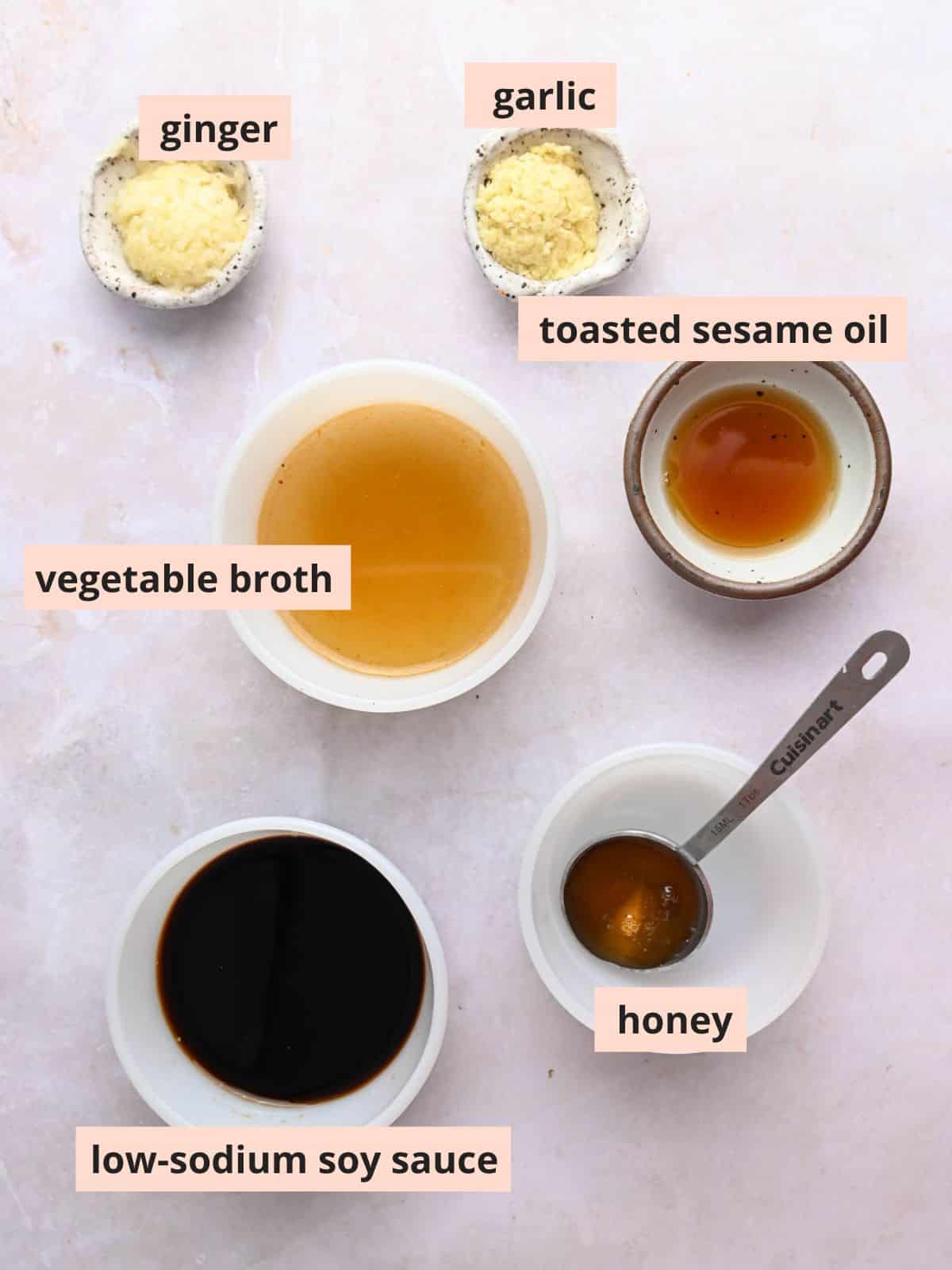
This recipe makes enough for 4 to 6 servings of stir fry noodles, vegetables, and protein.
- Soy sauce: The saltiness of soy sauce varies from brand to brand. I test my recipes with Kikkoman regular and Kikkoman less sodium soy sauce. Use an equal amount of tamari in place of soy sauce to make this recipe gluten-free.
- Vegetable broth: This thins out the sauce. I recommend broth instead of water to thin the sauce because it adds extra flavor to the final dish.
- Ginger and garlic: I recommend fresh ginger and garlic because they have a sharper flavor than powdered. If you don't have fresh ginger or garlic, use ½ teaspoon ground in place of 1 tablespoon fresh.
- Honey: This adds a touch of sweetness to balance out the salty soy sauce. An equal amount of maple syrup works as needed.
- Toasted sesame oil: This provides a complex, nutty flavor.
How to make
Because this stir-fry sauce takes only 5 minutes to make, there aren't many steps!

I do recommend grating the garlic and ginger on a microplane or box grater, which takes a couple of minutes. After that, simply add all ingredients to a jar or bowl and whisk to combine.

I like adding sauce ingredients to a mason jar, because the jar can be shaken to mix the sauce.
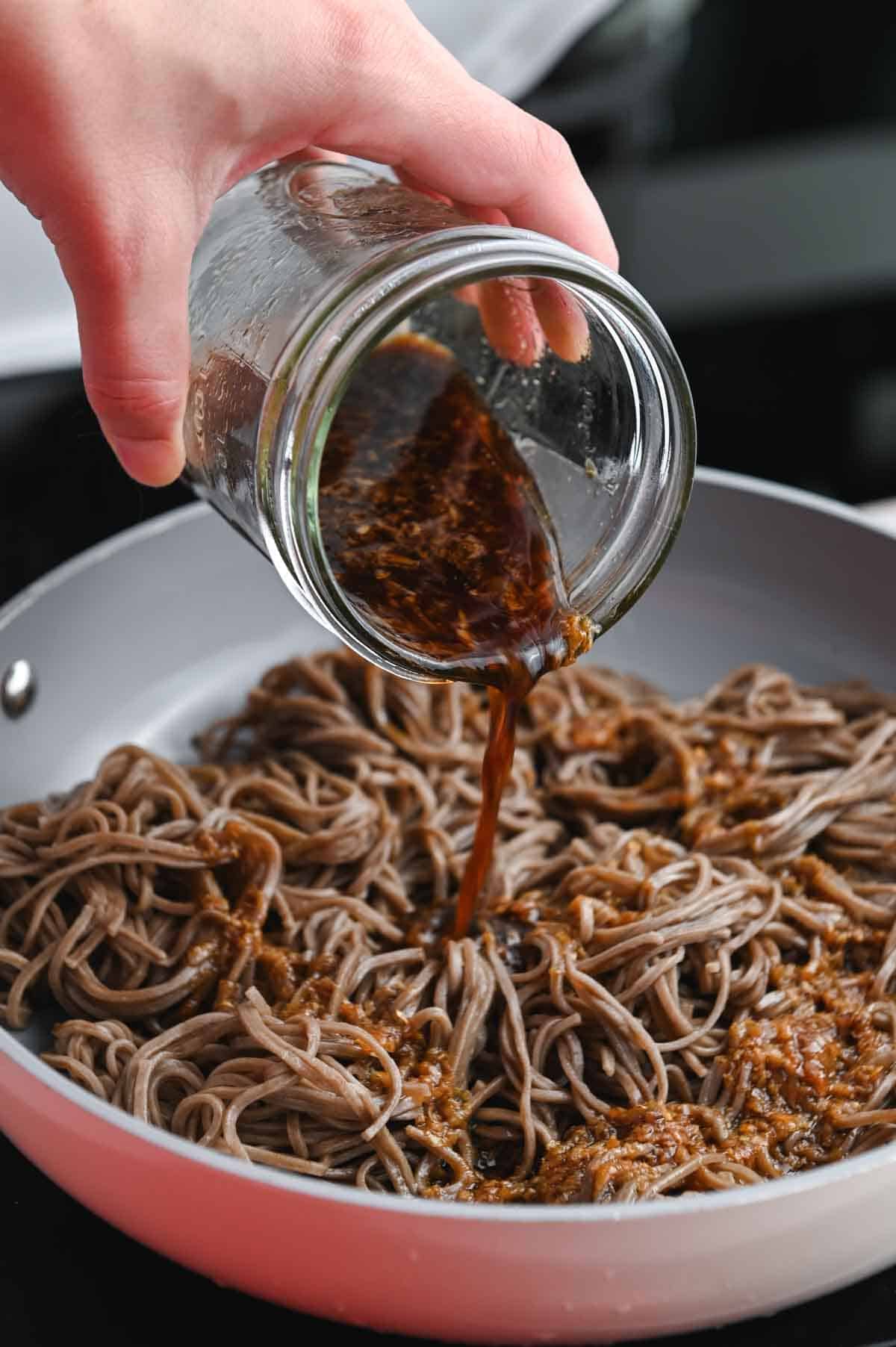
These are the general guidelines for making a vegetarian stir-fry:
- Heat a large skillet or wok over medium-high to high heat. Add high heat-tolerant cooking oil, such as canola oil or peanut oil.
- Once hot, add the protein, such as tofu or tempeh. Stir frequently, stirring until starting to brown.
- Add in the vegetables. Commonly stir-fried vegetables include broccoli, snap peas, peppers, and carrots. Continue cooking until the vegetables are vivid and tender, just a few minutes.
- Add in noodles or rice and the stir-fry sauce. If not adding a grain to the stir-fry, simply add the sauce at the end of cooking the vegetables. Cook another 2 minutes to heat the sauce and allow the flavors to infuse into the vegetables and protein.
Expert tips
- Add stir-fry sauce toward the end of stir-frying. I always add stir-fry sauce at the same time as noodles, or after the protein and vegetables are cooked.
- I recommend grating garlic and ginger on a microplane or box grater. Not only is it quicker than mincing, it also creates more surface area which allows for more infusion of garlic and ginger flavor into the sauce.
- Consistency: Many stir-fry sauces call for corn starch to act as a thickener. However, I don't find that this sauce needs to be thickened because cooking at higher heat causes quick evaporation of liquids, resulting in a concentration of the sauce. Also, the vegetables, noodles, and tofu absorb the sauce. Yum!
- If you prefer a thicker sauce, simply add 1 tablespoon of corn starch slurry, which is 1 tablespoon corn starch whisked with 1 tablespoon water to thin it.
- Make in advance: This sauce can be made up to 4 days in advance. The sauce should be refrigerated because it contains fresh ginger and garlic.
- To make vegan stir fry sauce: Replace the honey with an equal amount of maple syrup.
Flavor variations
- Saltiness: The saltiness of soy sauce can overpower a dish quickly. I recommend starting with just ¼ cup soy sauce and adding more to taste. I usually land on about ⅓ cup of reduced-sodium soy sauce.
- For a low-sodium option, start with just 2 tablespoons of low-sodium soy sauce and adjust to taste. It will still be a relatively salty dish, but using lower-salt soy sauce allows for more control over the final result.
- Black vinegar: I love adding a splash (let's say a tablespoon) of this at the end of stir-frying. Black vinegar is an umbrella term for Chinese vinegar. It has a complex flavor, but is most notably sweet, fruity, with a small amount of umami.
- Sweetness: For a sweeter teriyaki-style stir fry sauce, add ¼ cup light brown sugar and omit the honey. This is similar to the sauce I use in my teriyaki quinoa fried rice.
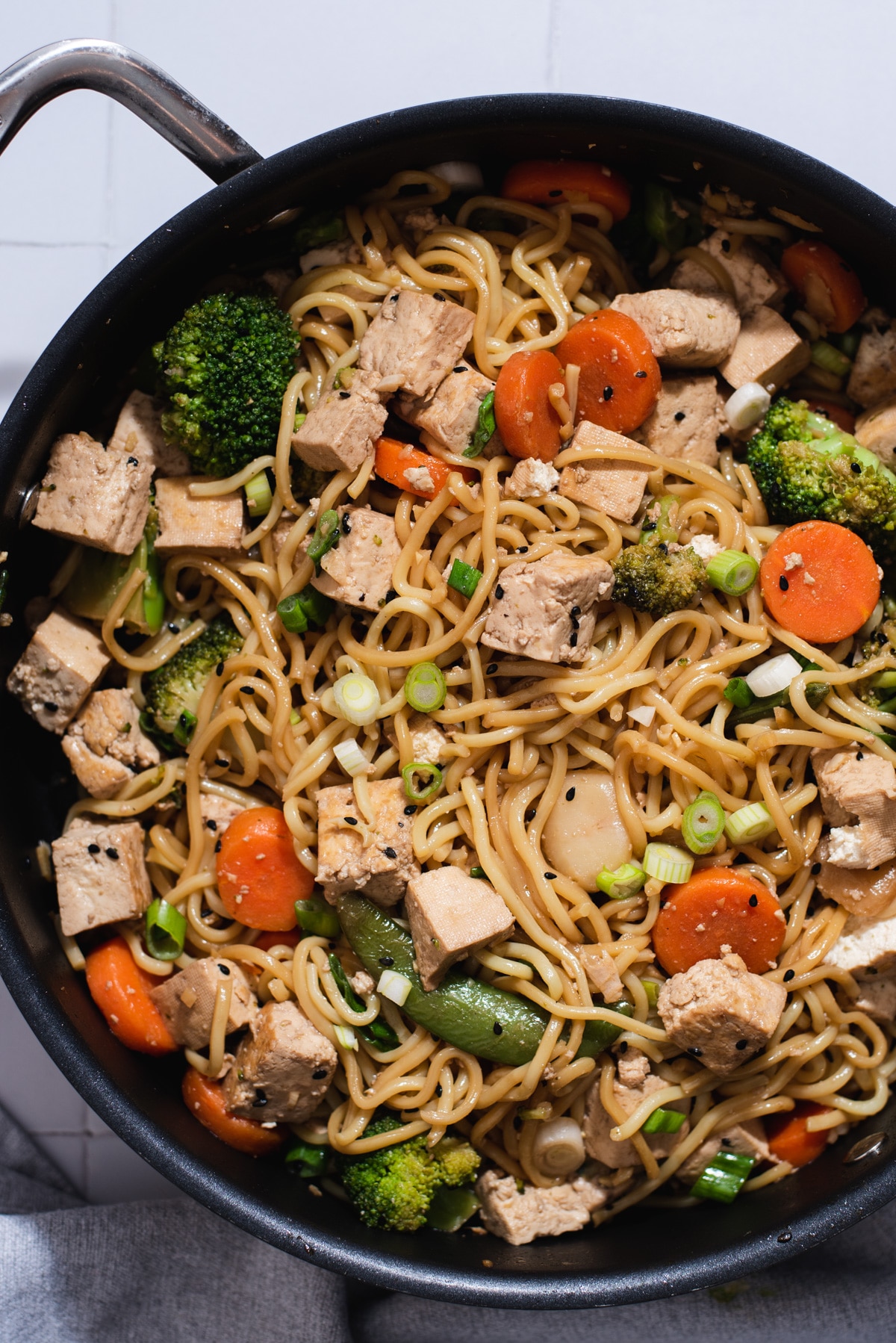
Looking for similar recipes?
Did you try this recipe? You can leave a star rating in the recipe card or a review in the comments below. Or check out my new cookbook and keep up to date with my YouTube, Instagram, TikTok, or newsletter!
📖 Recipe
Want to Save This Recipe?
Enter your email & I'll send it to your inbox. Plus, get great new recipes from me every week!
By submitting this form, you consent to receive emails from Cozy Peach Kitchen
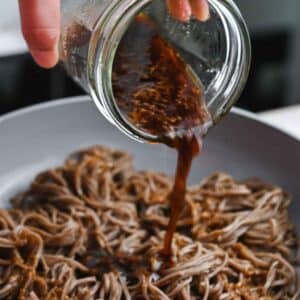
Vegetarian Stir Fry Sauce
Ingredients
- ¼ cup vegetable broth
- 4 to 6 tablespoons low sodium soy sauce see note #1
- 1 tablespoon grated ginger see note #2
- 1 tablespoon grated garlic
- 1 tablespoon honey or maple syrup
- 1 tablespoon toasted sesame oil
Instructions
Stir Fry Sauce
- In a small bowl or jar, whisk or shake together the vegetable broth, 4 tablespoons soy sauce, ginger, garlic, honey, and sesame oil. Taste for seasonings and add the remaining 1 to 2 tablespoons of soy sauce if desired.
How to Stir Fry
- In general, stir-frying involves protein, vegetables, and a grain, like noodles. Heat a large skillet or wok over medium-high to high heat. Add high heat-tolerant cooking oil, such as canola oil or peanut oil.
- Once hot, add the protein, such as tofu or tempeh. Stir frequently, cooking until starting to brown. Add in the vegetables. Commonly stir-fried vegetables include broccoli, snap peas, peppers, and carrots. Continue cooking until the vegetables are vivid and tender, just a few minutes.
- Add in noodles or rice and the stir-fry sauce. If not adding a grain to the stir-fry, simply add the sauce at the end of cooking the vegetables. Cook another 2 minutes to heat the sauce and allow the flavors to infuse into the vegetables and protein.
Notes
- Soy sauce: This recipe definitely works with standard soy sauce, but I recommend low-sodium soy sauce because it allows for more control over the saltiness of the stir-fry sauce.
- Grating: I grate ginger and garlic on a microplane or the smallest part of a box grater. I find it easier than mincing and the increased surface area of ginger/garlic adds more flavor to the sauce.
- No fresh ginger or garlic? Replace with ½ teaspoon ground equivalent. Adjust to taste.


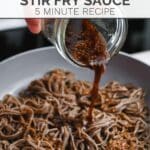





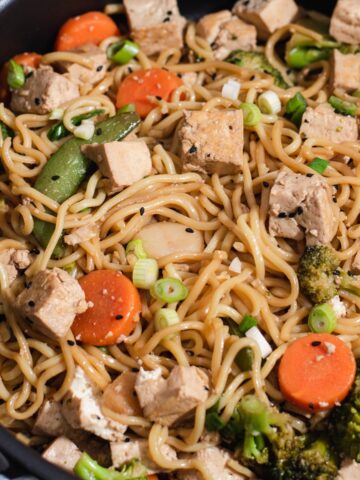
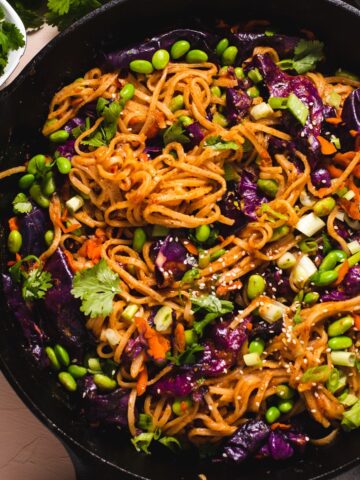
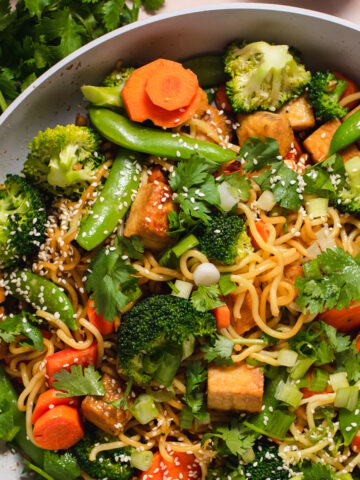
Comments
No Comments